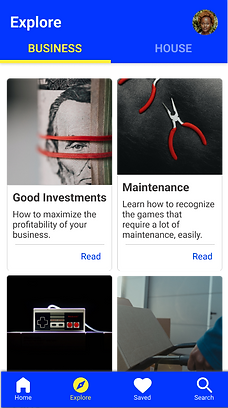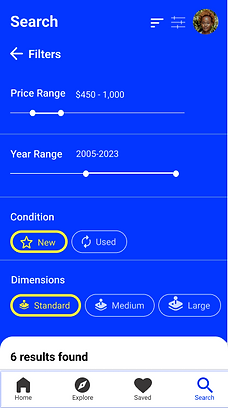ArcAid: An Arcade Preview Mobile App
ArcAid is a mobile application for Android that is aimed at helping arcade operators and home arcade players to preview, save, and compare arcade games easily. This project is the culmination of my learning about UX design in the Google UX Design Professional Certificate program. Follow my learning journey and explore how I applied the knowledge and skills I acquired in the program in this hands-on activity.

THE PROBLEM
To practice the steps of UX Design, I chose to design an arcade game preview app. After conducting foundational research, I developed the following problem statement: Arcade operators and home arcade players need a way to preview and compare a significant number of games easily because they want to make good investments for their businesses or homes. Based on my findings from competitive research, there is no tool for previewing and comparing games of different manufacturers and distributors easily.
ArcAid will allow users to search, preview, and compare arcade games from different manufacturers and distributors easily which will affect arcade operators and home arcade players by simplifying the game search and comparison process. Effectiveness will be measured by tracking the number of users and analyzing the users' scores and reviews.
EMPATHIZE


RESEARCH GOALS
First, I identified the user research goals. I was interested in understanding arcade owners' and home-arcade players' behaviors, experiences, thoughts, and feelings in finding games for their businesses or homes to get insight into their needs and motivations.
DATA COLLECTION METHODS
To practice the user research methods, first, I conducted semi-structured interviews. Since I could not recruit the required sample of arcade operators and home players, I interviewed some friends with diverse characteristics who buy games for their homes. Before the interview, I developed four open-ended questions in alignment with the research goals that I asked all the interviewees. Follow-up questions were asked accordingly. To address bias, I paid attention to the wording and the interviewees' body language and reviewed the recorded sessions to refresh my memory.
Due to access to a limited sample and in hopes to increase the validity of my findings, I watched videos of arcade owners on Youtube where they describe their experience in finding games for their business and reviewed home players' comments on a relevant group on Facebook until the same themes were coming up and no more new data could be gathered. To make the process more realistic, I used made-up bios that were provided in the course as an aid for the students.
EMPATHY MAPS
PERSONAS
JOURNEY MAPS
DEFINE
USER NEEDS
Overwhelming Process
The users visit the manufacturers’ websites, e-commerce, and local distributors' showrooms to find arcade games for their homes or businesses. They need a less time-consuming and inexpensive way to perform this task.
Bad Purchases
Existing online resources do not disclose the game’s ROI, replay value, and maintenance costs. Additionally, the buyers are not informed about important delivery and assembly details resulting in buying an arcade that doesn't fit.
PROBLEM STATEMENT & HYPOTHESIS
Alfie is a busy accountant with color blindness who needs an efficient way to preview and compare arcade games because they don't have enough time to visit the manufacturers' websites and the distributors' showrooms to view and compare arcade games. If Alfie downloads the arcade game preview app they will preview and compare a list of preferred games easily.
Carlos is an arcade operator who needs to preview and gather information about a significant number of games because he wants to make good investments in his business. If Carlos downloads the arcade game preview app he will preview and make effective comparisons of a significant number of games for his business.
IDEATE
COMPETITIVE AUDIT

At this stage in the project, I followed different strategies to ideate solutions, starting with research on the competitors. I evaluated the websites of four direct and indirect competitors and identified their strengths and weaknesses (See the competitive audit spreadsheet). This process, helped me identify the gaps in the market and get inspired by the strengths.
In general, I concluded that:
-
There is a gap in the market for a tool to compare arcade games from different manufacturers, distributors, and sellers easily. The existing applications are heavy in text and do not provide the users with tools to simplify the preview and comparison process and make purchase decisions.
-
The overwhelming majority of distributors' and manufacturers' websites are designed with arcade operators in mind, leaving home players out.
VALUE PROPOSITION
With the new application, the users will be able to:
-
Search for games from various manufacturers and distributors and preview the games easily due to the visual representation of information (wherever applicable) and the absence of heavy text.
-
Save games on a list.
-
Organize the saved games in the preferred order or delete them with a simple gesture.
-
Compare the saved games with just one click, share them with others, and finally archive them.
-
Read guides to improve the business or get inspiration for their home arcades.
-
Personalize the interaction with the content based on their needs (translate the content into other languages and choose a text size)
HOW-MIGHT-WE STATEMENTS
As another ideation technique, I developed different how-might-we statements:
-
Amp up the good. "How might we design an arcade game preview experience for different users?"
-
Break the point of view into pieces. "How might we help home arcade players find arcades without spending too much time? How might we help arcade operators find games to improve their business? How might we make the decision-making process easier for both users?"
-
Go for the adjective. "How might we design an easy, differentiated, flexible, and cognitive-load-free arcade game preview experience?"
-
Create an analogy. "How might we make the game preview experience analogous to the learning experience of students with different abilities?"
PROTOTYPE & TEST
FLOWCHART
With the users' needs in mind, I thought of the actions the users will perform to meet their goals and the screens they will experience after each action (see the flowchart above). Once on the homepage, the users can preview and save a game. Yet, they can break away from this flow to use the search feature, read guides to get inspired, see the list of saved games, and organize, compare, and archive them.

Once I developed a preliminary idea of the user flow, I created different versions of each screen on paper to explore various interface design approaches. Finally, I reflected on my designs and made the last refinements.
PAPER WIREFRAMES
FOCUS-GROUP RESEARCH
Before moving on to the digital wireframes, I conducted focus-group research to evaluate whether the design components reflect how the users think and talk about the various tasks in the decision-making process to purchase games. In a meeting with three participants, I shared the paper wireframes and asked for their thoughts about the concepts represented in the design from the arcade owners' and home players' perspectives. The data suggested that the users needed
-
better organization of the game categories on the homepage
-
a separate destination for articles and guides that were displayed on the homepage
-
a more intuitive way to display information on the game description page.
Limitations:
-
The small-size group game limited data.
-
Because the research was conducted remotely, I did not have the chance to collect non-verbal data, like the participants' body language and reactions.
DIGITAL WIREFRAMES
The users can search for games organized in categories on the homepage or by using the search tool on the bottom navigation bar. This feature aligns with the need for an easier and less time-consuming process of finding arcade games from different manufacturers and distributors.
.png)
The users can create a list of games and archive it on the app. Most importantly, they can compare the games with one click. The comparison table displays seven characteristics that I identified during the user research. This feature aligns with the need for a tool to simplify the decision process.
.png)

The users can read guides about how to improve their businesses or home arcades. This feature aligns with the need to learn about important aspects that relate to game purchases to make good investments.
.png)
The information on the game description page is displayed more effectively with the implementation of Meyer's principles for information presentation to avoid cognitive load. This feature aligns with the need to preview games easily without missing out on important information.
.png)
The users can personalize their searches by using filters like price, condition, and dimensions. This feature aligns with the need for an easy search process.
.png)
The app is aimed at providing an equitable experience for every user. For that reason, the design allows the users to change the language and the text size based on their needs.
.png)

LOW-FI PROTOTYPE
Using the complete set of digital wireframes, I created a low-fidelity prototype. Once on the homepage, the user can take different actions such as previewing the game and saving it. Yet, with the other three destinations at the bottom navigation bar, the user can break away from this flow to search games using keywords, read guides, see the list of saved games, organize them, compare them, and archive them. These are the user goals that I tested in the formative usability study.
FORMATIVE USABILITY TEST
With the prototype in place, I recruited 5 people to test it. Since this was an exploratory test, my goal was to gather performance and preference data about the app's usefulness and effectiveness, learn about what the users thought and felt about the preliminary design concepts, and see what I could learn from how they decide which arcade games to buy.
The performance data suggested that the preliminary designs were effective (96% of the tasks were completed successfully) but the users needed
-
better cues about how to optimize the game search according to their needs
-
better cues about how to save games
-
more effective design to be able to click on the whole title on the Settings page instead of the right arrow only
-
a more suitable place for the archived games
For more details about the process, read the research plan and the research report.
Limitations:
-
Convenience sampling: the sample was not fully representative of the target population
-
Small sample size
MOCKUPS






HIGH-FI PROTOTYPE
In the final high-fidelity prototype, I addressed all the errors of commission identified in the usability tests and improved the user flow for finding articles to improve the business and home arcade room, searching and saving games, comparing products, and archiving the created lists of games.
HIGH-FI PROTOTYPE USABILITY TEST
In the final high-fidelity prototype, I addressed all the errors of commission identified in the usability tests and improved the user flow for finding articles to improve the business and home arcade room, searching and saving games, comparing products, and archiving the created lists of games.
.jpg)
.jpg)
.jpg)
.jpg)